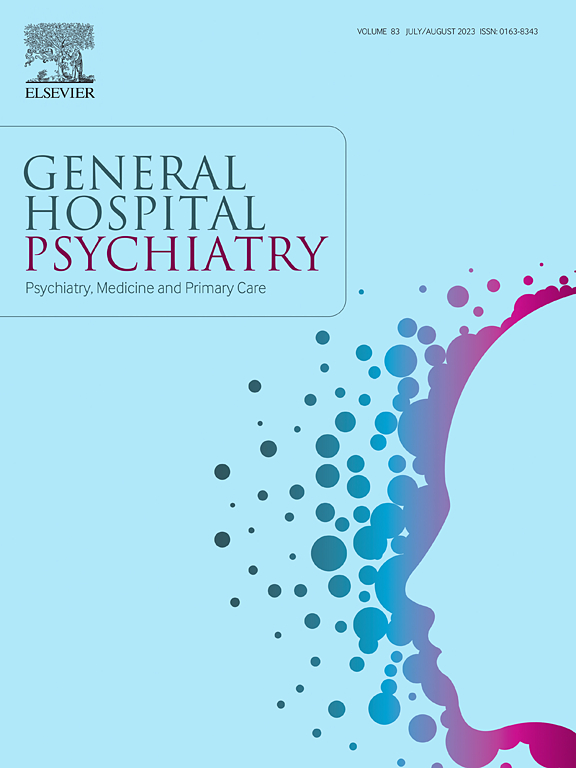Five-year survival following a non-small-cell lung cancer diagnosis among Veterans Health Administration patients with schizophrenia and bipolar disorder
IF 3.7
2区 医学
Q1 PSYCHIATRY
引用次数: 0
Abstract
Objective
Veterans with schizophrenia or bipolar disorder (SZ/BP) experience excess mortality due to several reasons, including cancer. We evaluated whether disparities exist in stage of non-small-cell lung cancer (NSCLC) diagnosis and survival between Veterans Health Administration (VHA) patients with and without SZ/BP.
Method
This retrospective evaluation used VHA data to identify patients newly diagnosed with NSCLC from 2005 to 2014. Bivariate analyses compared NSCLC stage at diagnosis by SZ/BP status. Kaplan-Meier and adjusted Cox proportional hazards regression analyses examined differences in survival by SZ/BP status. Meaningful differences were assessed using statistical significance, p < .01, and effect sizes of least 0.2 less/greater than 1.
Results
The cohort included 64,269 VHA patients with newly diagnosed NSCLC. These included 1605 (2.5 %) patients with schizophrenia and 1099 (1.7 %) with bipolar disorder. Stage at diagnosis did not meaningfully differ between patients with and without SZ/BP. After adjusting for stage of diagnosis and other factors, schizophrenia, but not bipolar disorder, was associated with an increased risk of five-year all-cause mortality compared to no SZ/BP (schizophrenia: HR 1.22, 95 % CI 1.14–1.30; bipolar: HR 1.01, 95 % CI 0.94–1.10).
Conclusions
VHA patients diagnosed with NSCLC who had schizophrenia experienced greater mortality compared to those without SZ/BP, despite no meaningful differences between the two groups in stage of NSCLC at diagnosis. Further work to understand drivers of this difference (e.g., access to NSCLC treatment) and subsequent interventions are needed.
退伍军人健康管理局诊断患有精神分裂症和双相情感障碍的非小细胞肺癌患者的五年生存率
患有精神分裂症或双相情感障碍(SZ/BP)的退伍军人由于多种原因(包括癌症)而经历过高的死亡率。我们评估了有无SZ/BP的退伍军人健康管理局(VHA)患者在非小细胞肺癌(NSCLC)诊断阶段和生存率方面是否存在差异。方法采用VHA资料对2005 - 2014年新诊断的NSCLC患者进行回顾性评价。双变量分析比较SZ/BP状态在诊断时的NSCLC分期。Kaplan-Meier和校正Cox比例风险回归分析考察了SZ/BP状态对生存率的影响。采用统计学显著性p <;.01,效应量至少为0.2,小于/大于1。结果该队列包括64269例新诊断为NSCLC的VHA患者。其中包括1605例(2.5%)精神分裂症患者和1099例(1.7%)双相情感障碍患者。有无SZ/BP患者的诊断分期无显著差异。在调整了诊断阶段和其他因素后,与没有SZ/BP的患者相比,精神分裂症患者的5年全因死亡率增加(HR 1.22, 95% CI 1.14-1.30;双相:HR 1.01, 95% CI 0.94-1.10)。结论svha诊断为非小细胞肺癌合并精神分裂症的患者死亡率高于无SZ/BP的患者,尽管两组在诊断时的非小细胞肺癌分期无显著差异。需要进一步的工作来了解这种差异的驱动因素(例如,获得非小细胞肺癌治疗)和随后的干预措施。
本文章由计算机程序翻译,如有差异,请以英文原文为准。
求助全文
约1分钟内获得全文
求助全文
来源期刊

General hospital psychiatry
医学-精神病学
CiteScore
9.60
自引率
2.90%
发文量
125
审稿时长
20 days
期刊介绍:
General Hospital Psychiatry explores the many linkages among psychiatry, medicine, and primary care. In emphasizing a biopsychosocial approach to illness and health, the journal provides a forum for professionals with clinical, academic, and research interests in psychiatry''s role in the mainstream of medicine.
 求助内容:
求助内容: 应助结果提醒方式:
应助结果提醒方式:


